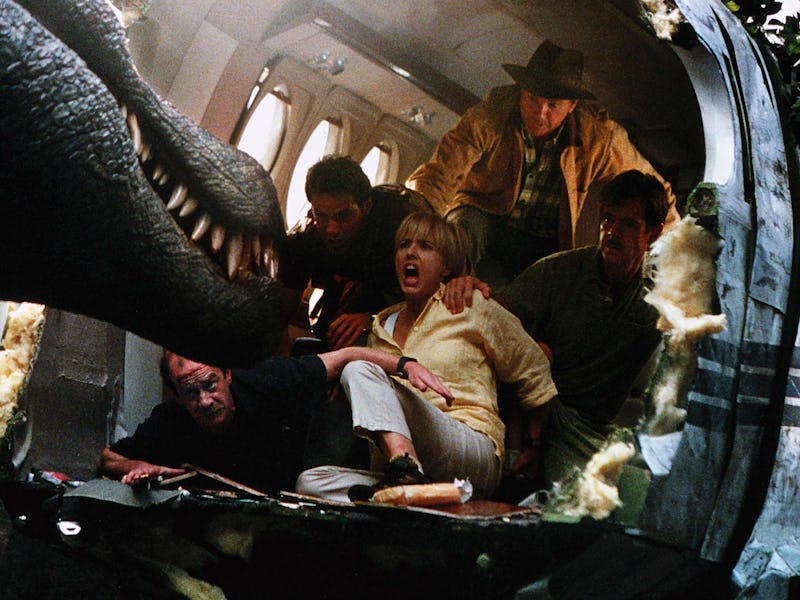Jurassic Park III saw the series try monster horror. Maybe it shouldn’t have.
With director Joe Johnston replacing Steven Spielberg, the beloved franchise upped the ante on monsters... and little else.

Nothing can touch Jurassic Park. Even Steven Spielberg swung and missed with his 1997 sequel The Lost World, fumbling the rare blessing of Jeff Goldblum in the lead role. There was no way a third film, sans Spielberg, could dazzle audiences like the first time they saw a roaming brontosaurus. But an attempt was made, and the result is as fascinating as it is baffling.
In the summer of 2001, two months before the world changed forever, Jurassic Park III opened in theaters to a strong box office (albeit the lowest-grosser in the franchise’s history) and tepid reviews. With Spielberg busy on A.I.: Artificial Intelligence and Band of Brothers for HBO, directing duties were left to Joe Johnston; given his experience on Jumanji, Johnston seemed like the right candidate for a movie where humans run from oversized beasts.
Though Johnston has his strengths, evidenced by his overlooked pulp homages The Rocketeer and Captain America: The First Avenger, Jurassic Park III is devoid of his own proven sense of scope, spectacle, and humanity. An explicit action-horror hybrid that fails to succeed in either genre, the film rightfully earns its bottom-rung placement in ranked listicles. It’s only the gift of hindsight, and the inert execution of the successor Jurassic World sequel trilogy, that affords Jurassic Park III any appeal in its modest charms. Those charms can now be seen on HBO Max, at least until the end of the month.
Released in an era when sequels were still episodic rather than serialized, Jurassic Park III features Sam Neil back as archaeologist Alan Grant. Still a stickler for the dignity of science (and still unable to connect with kids), Alan is troubled by the dwindling support for his research. He’s also fatigued by the spectacle dinosaurs have become. A line referencing The Lost World reaches near Deadpool-levels of meta, when Neil — as Grant at a speaking event — wryly smirks at the delivery of, “The incident in San Diego, which I did not witness?” Soon, Grant is compelled by a divorced couple (Téa Leoni and William H. Macy), who deceive him to look for their son Eric (Trevor Morgan), last seen parasailing in Isla Sorna, a remote island overrun by InGen’s dinosaur experiments.
In contrast to Spielberg’s earlier films, Jurassic Park III goes all-in as a monster horror. Never mind that the dinosaurs — especially the vicious spinosaurus — never come off any more dangerous than we’ve seen them before, due to Johnston lacking the craftsmanship for suspenseful blocking. Though the primitive CGI holds up, even blending into what few animatronics were used, the visible predominance of computerized dinosaurs feels like an ill omen for the next 20 years of mainstream Hollywood.
Few who saw Jurassic Park III in July 2001 could have known it, but seeing it then was like bearing witness to a mediocre future in which only breakthroughs like Avatar could produce the feeling of progress. Even a scene that meticulously replicates an iconic scene from the 1993 film feels hollow and cheap, no matter how much more expensive it might have been.
Jurassic Park III strives for the majesty of Jurassic Park but fails to reach the same heights.
There’s early promise of quality and ingenuity in the prologue, when a parasailing Eric flies through the clouds and, after an alarming shaking, witnesses the sailors below him mysteriously vanish. It’s tragic that the rest of the movie never lives up to this moment, and the film sputters and rushes to a climax that’s hastily resolved with a 3D-printed velociraptor throat.
The worst of Jurassic Park III’s sins is how it bears little trace of the franchise’s persistent themes of science as a vehicle for humanity’s arrogance. Early in the movie, Grant insists that only true science can be learned from true fossils. “What John Hammond and InGen did at Jurassic Park is create genetically engineered theme park monsters,” he argues. Jurassic Park III never grills this in any meaningful way, and even contradicts its own message when it offers nothing but theme park set pieces that fail to resonate past the end credits.
There are traces of creativity in this barebones script, and they’re worth watching now, especially to contrast with the equally boneheaded Jurassic World sequels. But finding them is like scraping off the remnant meat of an already-excavated dinner. Dinosaurs roamed Earth 65 million years ago, but Jurassic Park III’s 92-minute length feels just as long.
Jurassic Park III is streaming on HBO Max through January 31.
This article was originally published on